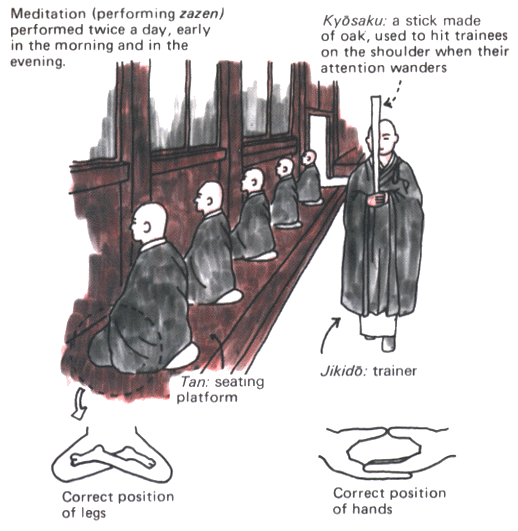

Zen and Zazen, JNTO
Zazen is Japanese name given to the seated meditation. While zen meditation may refer to walking meditation or various forms of mental training, zazen directly refers to meditating by sitting with the sole focus on breathing, posture and calmness. Many temples in Kyoto have 30-40 minute introductory level zazen practice sessions, but, according to the avg. Japanese, zazen is a practice that lasts for hours and days without a single movement.
Zazen’s focus on breathing is important as studies show that breathing slowly and smoothly creates the feeling of calmness. Additionally inhaling from the nose and exhaling from the mouth has been found to reduce stress strengthen our immune system and regulate and balance our central nervous system and heart rate where irregularities may occur.
We have to note that there are different kinds of zen schools namely rinzai, soto and obaku and each school practices zazen differently. The practitioners of Rinzai zen face other students during zazen while the Soto zen members face the wall. Kyosaku , the bamboo stick where the master hits the back of the mediator after the request of the mediator is more common in the soto zen. It should not hurt much and the purpose is to eliminate sleepiness of the meditator.
How to Zazen
Focus on Posture: We have to sit crosslegged by holding our hands on our laps as shown in the pictures above. Straight posture, not over stretched and nor slouching, is very important to not to fall asleep. Right hand is held palm up and left hand is put above the right palm. Thumbs should be touching and very gently pushing each other. There is no rule for the eyes but it is recommended to look 45 degrees in front and focus something on the floor or on the wall to not to fall asleep.
The crosslegged sitting position looks like the lotus flower and called the lotus position. Lotus flower is the symbol of perseverance as it grows in muddy waters and also represents pure mind and spirit. If the feet could be placed on the thighs, it is called the full lotus, if the feet are below the thighs it is called the laf-lotus position.
Focus on Breathing: Slowly breathing in and slowly breathing out from the nose each taking around 10 seconds is ideal. Most beginners count the breath each time they exhale. Counting helps prevent mind wandering. We should notice the bodily changes such as expansion of our lungs and stomach while inhaling and the shrinking of our lungs and stomach while exhaling. Meditation is a great opportunity to discover our body and true nature.
Focus on Mindfulness: In order to meditate properly, we have to remember the simple principles of Zen:
- We have to realize that humans dislike too much stimuli (noise) and too little stimuli (boredom). Zen mind is being OK with and then enjoying too little stimuli. This is also a mental detox to help us enjoy small things in everyday life.
- We are not present in the moment because we think about what happened in the past or what will happen in the future. Zen mind is remembering that time is one piece and there is only one time that is “now.”
- We sometimes think doing nothing is wasting time and being unproductive. Zen mind is realizing that desire to be productive for 24 hours is the biggest reason for our stress. Wanting more is the ultimate cause of suffering because there is no limit to our wants and chasing “more” almost always means ignoring what we already have.
- We may not be able to relax because we may be bothered by the fact that we cannot move our body our feet may feel uncomfortable. Zen training is mostly about tolerating discomfort and being OK with it. For example, if a broken faucet in the bathroom which is dripping drives you crazy and stops you doing anything until the repairman comes, you do not have the ability of tolerance. The moment you are OK with the dripping sound is the moment you will have a peace of mind.
- We may not be able to meditate because we may have so many different thoughts in our minds. Zen mind is welcoming our thoughts but not engaging with them. A good analogy is treating our thoughts like clouds passing by; seeing them but not focusing on them or analyzing them.
- We may not be able meditate because we may be stressed before the meditation starts. Often times our stress is caused by our judgments, fears and our negative evaluations of the environment. The moment we stop judging is the moment we would become more calm. The moment we stop judging is the moment we reach mental freedom.
“The art of zazen is thinking without thinking [5], is the beginner’s mind, the mind of many possibilities, different from the expert’s mind, one of several possibilities. ” Cited in Georgescu, 2011.

Zen and Zazen, JNTO

Zen and Zazen, JNTO
The Soto zen school focuses on simple seated meditation also known as shikantaza while the Rinzai school emphasizes the importance of koans (philosophical riddles) as part of the meditation.
Contact us : info@mai-ko.com
